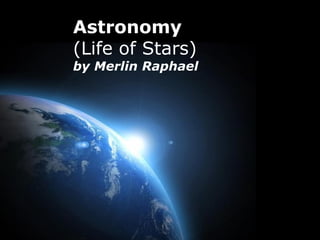
Life of Stars
- 1. Astronomy (Life of Stars) by Merlin Raphael Page 1
- 2. The Universe Scientists believe the universe began in a “big bang”, about 13,700 million years ago. The universe continues to expand today. The evidence for the “big bang” theory includes the existence of a microwave background radiation and red shift. The universe contains extremely dense objects and may consist mostly of dark matter that cannot be seen. Stars do not remain the same- they change as they age. Page 2
- 3. The Origin of Stars Nebula: A large cloud of gas (helium and hydrogen) and dust which forms into a star. Dust and gas particles exert a gravitational force on each other which keeps pulling them closer together. As the particles pull closer together the temperature increases. At 10,000,000o C fusion takes place and energy radiates outward through the condensing ball of gas. Page 3
- 4. -Cloud Collapse - occurs deep in cloud -“EGGS” (Evaporating Gaseous Globules) : Dense regions forming new stars - surrounding gas & dust “eaten into” by strong stellar winds, UV photons & ionization fronts. Page 4
- 5. The Star A star is a luminous globe of gas producing its own heat and light by nuclear reactions. They are born from nebulae and consist mostly of hydrogen and helium gas. Surface temperatures range from 2000°C to above 30,000°C, and the corresponding colours from red to blue- white. Page 5
- 6. Red Giants After hydrogen is exhausted in core, energy released from nuclear fusion counter- acts inward force of gravity. -Core collapses, •Kinetic energy of collapse is converted into heat. •This heat expands the outer layers. -There is an increase in temperature and pressure during the collapse. Page 6
- 7. Planetary Nebula Planetary nebulae are the outer layers of the star that are lost when it changes from a red giant to a white dwarf. After helium is exhausted, the core collapses and the outer layer of the star is expelled. The outer atmosphere is ionized by the hot remaining core. Page 7
- 8. White Dwarf White dwarfs are the shrunken remains of normal stars whose nuclear supplies have been used up. They consist of degenerate matter with a very high density due to gravitational effects. A white dwarf cools and fades over several billion years. Page 8
- 9. Supernova This is the explosive death of a star. It often results in the star obtaining the brightness of 100 million suns for a short time. Type1- These occur in binary star systems in which gas from one star falls onto a white dwarf, causing it to explode. Type2- These occur in massive stars, which suffer runaway internal nuclear reactions at the end of their lives. Page 9
- 10. Neutron Stars These stars are composed mainly of neutrons and are produced when a supernova explodes, forcing the protons and electrons to combine to produce a neutron star. It is very dense. Typical stars have a mass of 3 times the sun, but a diameter of only 20km. If its mass is any greater, it will shrink further to become a black hole. Page 10
- 11. Black Holes These are believed to form from massive stars at the end of their lifetime. The gravitational pull in a black hole is so great, nothing can escape from it- not even light. The density of matter in a black hole cannot be measured. Black holes distort the space around them, and can often suck neighboring matter into them, including stars. Page 11
- 12. Page 12